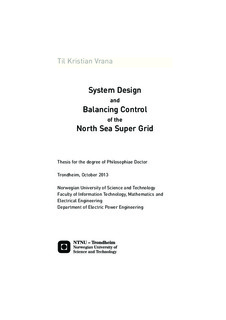| dc.contributor.author | Vrana, Til Kristian | nb_NO |
| dc.date.accessioned | 2014-12-19T13:54:39Z | |
| dc.date.available | 2014-12-19T13:54:39Z | |
| dc.date.created | 2013-10-23 | nb_NO |
| dc.date.issued | 2013 | nb_NO |
| dc.identifier | 658958 | nb_NO |
| dc.identifier.isbn | 978-82-471-4757-3 (printed ver.) | nb_NO |
| dc.identifier.isbn | 978-82-471-4758-0 (electronic ver.) | nb_NO |
| dc.identifier.uri | http://hdl.handle.net/11250/257697 | |
| dc.description.abstract | The construction of the North Sea Super Grid is the major step towards meetingthe future demand for electric power transmission in northern Europe. This gridwill likely also extend onshore towards the load centres, and eventually form theEuropean Super Grid.Large-scale electric power generation at remote locations will lead tosignificant long distance power flows with a preferred flow direction. A methodto identify these unidirectional flows has been developed and applied on a casestudy, indicating the importance to consider unidirectional flows when designinga super grid.Voltage source converter based HVDC appears to be the best technicalsolution for the implementation of long distance transmission in such an offshoresuper grid. AC technology appears to be the most convenient choice for offshorenodes, but DC might also gain importance in this field, if reliable and affordableDC protection systems become available. A meshed DC grid offers significantadvantages towards a solution with many independent point-to-point HVDClinks, but also here protection is an unsolved issue that has to be overcome first.Reliability assessment of HVDC-based super grids is still very difficult,because operational experience with new technologies like the modularmultilevel converter is limited. This leads to a lack of data to calculate thefailure probabilities.A test system with a DC grid and the connected AC grids has been developedto serve as a common reference for a variety of DC grid studies.Unlike classical AC grids, DC grids will be dominated by power electronicsand the system behaviour will be determined to a large extent by the controllersof those power electronic systems. Large-scale implementation of powerelectronics with inappropriate control design has led to problems in AC systemsbefore. Photovoltaic generation systems in Germany are a good example forthis.A simplified AC frequency model has been developed to assess how powerelectronic systems influence the grid frequency. This model has been used to simulate how photovoltaic generation systems in Germany can endanger systemstability. A ‘grid-friendly’ charging controller for plug-in electric vehicles withbattery storage has been developed, and simulations have indicated that thiscontrol can contribute significantly to system stability.Even though AC and DC grids have some significant differences, some ofthe general concepts and lessons regarding balancing are true for both, andtomorrow’s DC grids can learn from today’s AC challenges.The balance in a DC grid should be defined as a current balance rather thanan active power balance (as it is used in AC grids), and the voltage can serve asa balance indicator, similar to AC frequency in AC grids. The control base forcontrolling the voltage should also be current instead of active power, leadingto linear system behaviour and a linear control task.HVDC converter control methods can be regarded as cases of droop controlwith one or more linear segments in the characteristic control curve. Withinone linear segment of the control curve, a HVDC converter can be representedby the Thevenin or Norton equivalent circuit.To unify a variety of proposed control concepts, Undead-band droop controlhas been proposed as a general piece-wise linear voltage control, which includesall other proposed methods as special implementations of undead-band droopcontrol. This concept could also be applied for other tasks than DC voltagecontrol like AC frequency control. | nb_NO |
| dc.language | eng | nb_NO |
| dc.publisher | NTNU | nb_NO |
| dc.relation.ispartofseries | Doctoral Theses at NTNU, 1503-8181; 2013:311 | nb_NO |
| dc.relation.haspart | Vrana, Til Kristian; Fosso, Olav B. Technical Aspects of the North Sea Super Grid. ELECTRA. (ISSN 1286-1146)(258): 6-19, 2011. | nb_NO |
| dc.relation.haspart | Vrana, Til Kristian; Huertas-Hernando, Daniel; Fosso, Olav Bjarte. Benefits of Asymmetric HVDC Links for Large Scale Offshore Wind Integration. 2012 IEEE POWER AND ENERGY SOCIETY GENERAL MEETING Conference Proceedings: 1-6, 2012. 10.1109/PESGM.2012.6345412. | nb_NO |
| dc.relation.haspart | Cole, S.; Vrana, Til Kristian; Curis, Jean-Baptiste; Liu, Chen-Ching; Karoui, Karim; Fosso, Olav B; Denis, Anne-Marie. A European Supergrid. Proceeding - 17th Power Systems Computations Conference PSCC 2011, 2011. | nb_NO |
| dc.relation.haspart | Vrana, Til Kristian; Dennetiere, Sebastien; Yang, Yongtao; Jardini, Jose; Jovcic, Dragan; Saad, Hani. The CIGRE B4 DC Grid Test System. ELECTRA. (ISSN 1286-1146), 2013. | nb_NO |
| dc.relation.haspart | Kaestle, Gunnar; Vrana, Til Kristian. Improved requirements for the connection to the low voltage grid. CIRED Conference Proceedings, ISSN 2032-9644, 2011. | nb_NO |
| dc.relation.haspart | Vrana, Til Kristian; Hille, Christian. A novel control method for dispersed converters providing dynamic frequency response. Electrical engineering (Berlin. Print). (ISSN 0948-7921). 93(4): 217-226, 2011. 10.1007/s00202-011-0210-x. | nb_NO |
| dc.relation.haspart | Vrana, Til Kristian; Beerten, Jef; Belmans, Ronnie; Fosso, Olav Bjarte. A classification of DC node voltage control methods for HVDC grids. Electric power systems research. (ISSN 0378-7796). 103: 137-144, 2013. 10.1016/j.epsr.2013.05.001. | nb_NO |
| dc.relation.haspart | Vrana, Til Kristian; Zeni, Lorenzo; Fosso, Olav B. Active Power Control with Undead-Band Voltage&Frequency Droop for HVDC Converters in Large Meshed DC Grids. , 2012. | nb_NO |
| dc.relation.haspart | Vrana, Til Kristian; Zeni, Lorenzo; Fosso, Olav B. Dynamic Active Power Control with Improved Undead-Band Droop for HVDC Grids. , 2012. | nb_NO |
| dc.title | System Design and Balancing Control of the North Sea Super Grid | nb_NO |
| dc.type | Doctoral thesis | nb_NO |
| dc.source.pagenumber | 236 | nb_NO |
| dc.contributor.department | Norges teknisk-naturvitenskapelige universitet, Fakultet for informasjonsteknologi, matematikk og elektroteknikk, Institutt for elkraftteknikk | nb_NO |
| dc.description.degree | PhD i elkraftteknikk | nb_NO |
| dc.description.degree | PhD in Electric Power Engineering | en_GB |


